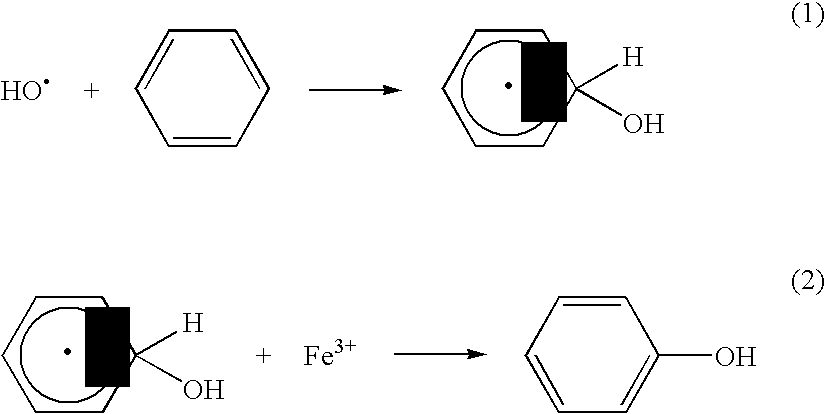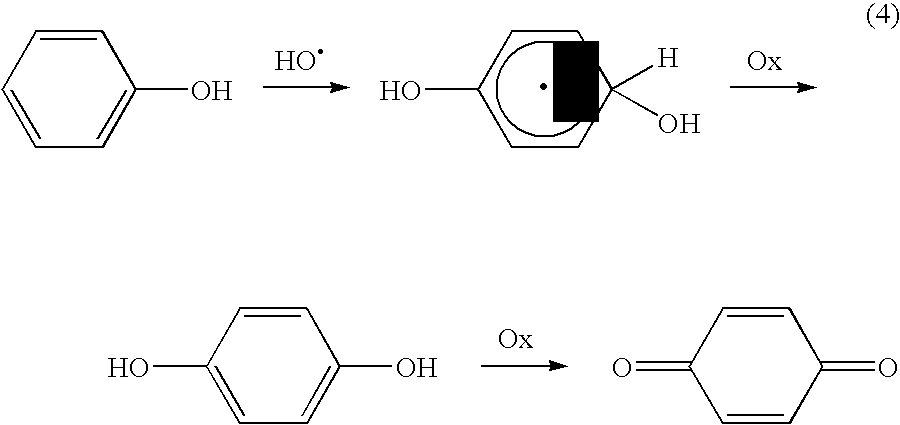Method of producing hydroxyl radicals for chemical reactions
a technology of hydroxyl radicals and chemical reactions, applied in water treatment compounds, water/sludge/sewage treatment, water contaminants, etc., can solve the problems of uncontrollable reaction and slow kinetics
- Summary
- Abstract
- Description
- Claims
- Application Information
AI Technical Summary
Benefits of technology
Problems solved by technology
Method used
Image
Examples
example 2
Phenol yield was improved by ultrasound radiation (US) to varying degrees, depending upon the input mode, power and other conditions.
Table 1 lists the yields of phenol achieved using the immersed sonic probe shown in FIG. 3. The probe 1 was immersed directly into the sample 2 contained in a reaction vessel 3. The experiments were optionally performed in an inert atmosphere and so gas inlets 4 and outlets 5 were provided. A cooling bath 6 normally surrounded the reaction vessel 3 as the application of ultrasound typically resulted in an increased temperature. A titanium horn 7 produced the ultrasound energy which was directed into the sample 2 via the probe 1.
At a reaction temperature of 35.degree. C. (entry 1 of Table 1), phenol yield after 30 min reaction was double that achieved under the same conditions without US input. This shows clearly the positive effect of US on the synthesis. An increase in US input power from level 3 (entry 1) to level 5 (entry 2), however, did not result...
example 3
Table 2 shows phenol yields achieved under various conditions using the ultrasonic cup-horn bath. A standard configuration of an ultrasonic cup-horn bath is shown in FIG. 4.
FIG. 5 shows a cup-horn bath used in this example. A reaction vessel 23 was immersed into a water bath 30. Iron electrodes 31, 32 were inserted into the reaction mixture 22. A reference electrode 33, stirrer 34, and temperature probe 35 were normally inserted into the reaction mixture 22. The H.sub.2 O.sub.2 is normally added via the burette 36.
Comparison between entry 2 in Table 2 and entry 2 in Table 1 shows that the bath is more effective than the probe: the yield increased from 2.3% to 6.2% after 60 min reaction even under a reduced radiation duration (50% as opposed to 100%). Using the same US bath and at the same power level (level 5), the yield is increased significantly by extension of radiation time from 20 to 50% of cycle duty (entries 1 and 2 of Table 2). A simultaneous increase in US power and hydroge...
example 4
In order to establish the appropriate conditions for Fe.sup.2+ generation using the iron electrode, we studied the dissolution and passivation features of metallic iron in acetonitrile-water mixtures in comparison with neat solvents. Such mixtures are created when an aqueous solution of hydrogen peroxide is added to acetonitrile to initiate the reaction. Experiments showed that in acetonitrile without added water, the passive oxide film on iron formed during air exposure is maintained over a wide potential range (up to 0.5 V) and active dissolution (predominantly in the form of Fe.sup.2+) is absent. Iron dissolution occurs in the transpassive region more positive than 1.2 V (most likely in the form of Fe.sup.3+ which is not directly useful for the synthesis). Active dissolution, however, can be effected by addition of a small proportion of water.
FIG. 1a shows a cyclic voltammogram showing the dissolution and passivation features of iron in acetonitrile-water mixtures. The electrolyt...
PUM
| Property | Measurement | Unit |
|---|---|---|
| weight | aaaaa | aaaaa |
| thickness | aaaaa | aaaaa |
| power | aaaaa | aaaaa |
Abstract
Description
Claims
Application Information
 Login to View More
Login to View More - Generate Ideas
- Intellectual Property
- Life Sciences
- Materials
- Tech Scout
- Unparalleled Data Quality
- Higher Quality Content
- 60% Fewer Hallucinations
Browse by: Latest US Patents, China's latest patents, Technical Efficacy Thesaurus, Application Domain, Technology Topic, Popular Technical Reports.
© 2025 PatSnap. All rights reserved.Legal|Privacy policy|Modern Slavery Act Transparency Statement|Sitemap|About US| Contact US: help@patsnap.com



